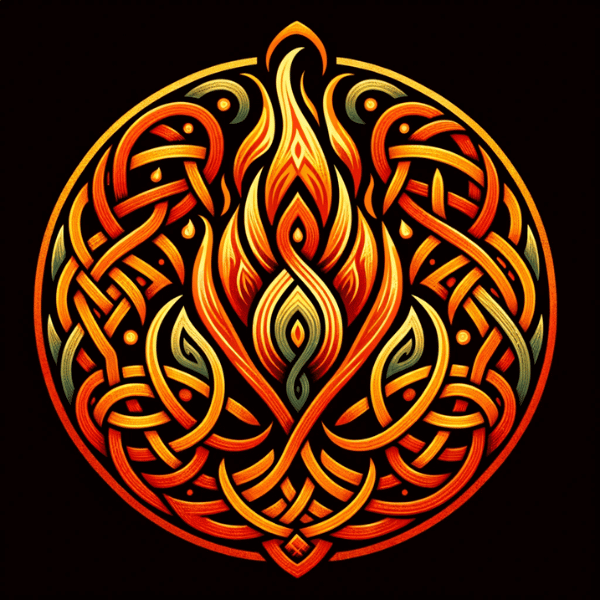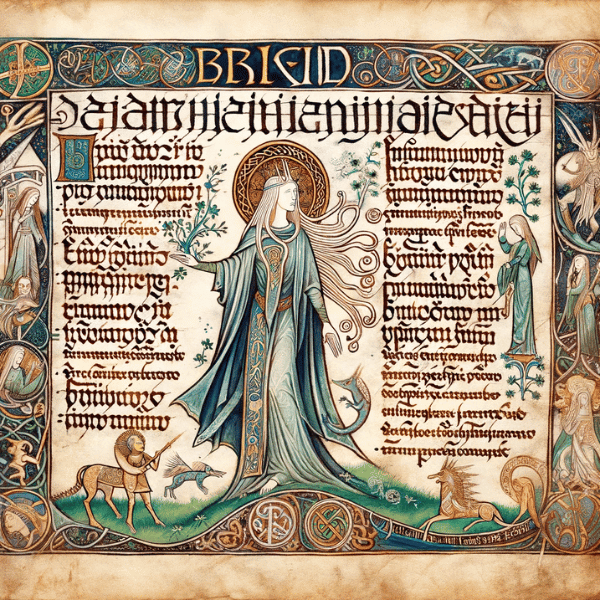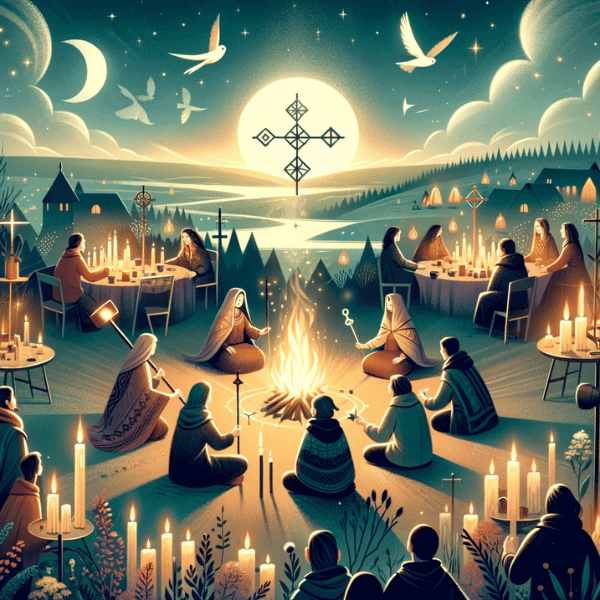Celtic mythology, a tapestry of tales and legends woven through the ancient Celtic people’s history, serves as a rich backdrop to the intriguing pantheon of gods and goddesses they revered. Among these divine figures, Brigid stands out with her profound significance. Revered as a goddess of fire, healing, and poetry, Brigid’s influence extends beyond the spiritual realm into the everyday lives of the Celts. She embodies the essence of inspiration and protection, merging the mystical with the practical. Her story, deeply embedded in Celtic lore, offers a window into the values and beliefs of a culture that has captivated the imagination for centuries. Brigid’s multifaceted role in Celtic mythology, from nurturing life to sparking creative fervor, highlights her as a pivotal figure whose legacy continues to inspire and resonate in modern times.
| Attribute | Brigid Information |
|---|---|
| Origin | Celtic Mythology |
| Deity Type | Goddess of Fire, Poetry, and Healing |
| Role | Goddess associated with fire, poetry, healing, and fertility |
| Triple Goddess | Often depicted as a triple goddess with three aspects: Brigid the Poet, Brigid the Healer, and Brigid the Smith |
| Festivals | Celebrated during Imbolc, a festival marking the beginning of spring |
| Cultural Impact | Revered as a symbol of inspiration, creativity, and the changing seasons |
| Depictions | Featured in Celtic mythology and folklore, particularly in Ireland, where she is a beloved figure |
1. The Historical Origins of Brigid
Historical Origins in Ancient Celtic Society
Brigid’s roots in ancient Celtic society are profound and multifaceted. Initially, she was revered as a goddess of fire, which symbolized the hearth and home, a central element in Celtic daily life. Her domain extended to aspects of healing, fertility, and craftsmanship, reflecting the Celts’ reverence for nature and its cycles. Brigid was also a patron of poets and bards, indicative of the high value placed on storytelling and oral tradition in Celtic culture. This reverence for Brigid underscores the Celts’ deep connection with the natural world and their belief in the sanctity of art and craft.

From Pagan Roots to Christianization
The transformation of Brigid from a pagan goddess to a Christian saint is a remarkable journey that mirrors the broader Christianization of Celtic lands. As Christianity spread, it adapted the figure of Brigid, evolving her into Saint Brigid of Kildare, who became a patron saint of Ireland. This transition exemplifies the syncretism in religious practices during this era, as Christian saints often merged with pagan deities to facilitate the conversion process. The story of Saint Brigid, retaining many of the goddess’s attributes, became a powerful symbol of continuity and change in a society navigating the crossroads of old and new beliefs.
Analysis of Ancient Texts and Archaeological Evidence
The study of ancient texts and archaeological evidence offers invaluable insights into Brigid’s significance in Celtic society. Inscriptions, artifacts, and ancient manuscripts such as the Lebor Gabála Érenn (The Book of the Taking of Ireland) provide a mosaic of information. These sources reveal how Brigid was celebrated and worshipped, with evidence of festivals in her honor, such as Imbolc, marking the beginning of spring. The analysis of these materials not only cements Brigid’s status in Celtic mythology but also provides a broader understanding of Celtic religious practices and societal values.

2. The Many Roles and Symbols of Brigid
Brigid as the Goddess of Fire
Brigid’s association with fire is not merely literal but deeply symbolic, embodying transformation, inspiration, and the life-giving aspects of the sun. In ancient Celtic society, fire was central to survival and ritual, and Brigid’s guardianship over it made her an essential deity. This symbolism extended to the spiritual realm, where fire represented the spark of creativity and divine inspiration, aligning with Brigid’s role as a muse for poets and artisans.
Brigid in Poetry and Bardic Traditions
In the realm of poetry and bardic traditions, Brigid’s influence was profound. She was seen as a patroness of bards and poets, revered for her gift of eloquence and expression. This role highlights the Celts’ deep appreciation for the spoken word and storytelling, with Brigid at the heart of this cultural practice. Her connection to bardic tradition underscores the sacredness of communication and the power of words in Celtic society.
Healing and Medicine
Brigid, revered as a protector and healer, guarded the wellbeing of individuals and communities beyond her artistic domains. Celtic culture, which intertwined spiritual wellness with physical healing, reflected a holistic view of health. People invoked Brigid’s healing powers for various ailments, symbolizing hope and renewal.
Fertility and Agriculture
Brigid’s role extended to fertility and agriculture, reflecting the agricultural calendar of the Celts and their dependence on the land’s cycles. Festivals such as Imbolc celebrated her as a harbinger of spring and renewal, vital for crop growth and livestock fertility. This association underscores her importance in ensuring the community’s sustenance and prosperity.
Iconography
In iconography, Brigid is often represented by symbols that encapsulate her diverse roles. The Brigid’s cross, made from rushes, symbolizes protection and is a common sight in Irish homes. Flames and wells are other recurrent motifs, representing her connection to fire and healing waters. These symbols serve not only as representations of Brigid’s power but also as tangible connections to the divine, offering protection and blessings to those who venerate her.

3. Brigid’s Festivals and Modern Celebrations
Imbolc – Origins, Customs, and Contemporary Practices
Imbolc, celebrated on February 1st, marks the beginning of spring in the Celtic calendar and is intimately associated with Brigid. Historically, Imbolc was a time of weather divination and ritual purification, signaling the end of winter and the preparation for spring. Traditionally, it involved lighting fires, a homage to Brigid’s aspect as a fire goddess. In contemporary practices, Imbolc is still celebrated by many, often with candlelit processions, poetry readings, and the crafting of Brigid’s crosses. These modern observances not only honor Brigid but also reconnect participants with ancient seasonal rhythms and practices.

Enduring Legacy in Modern Celtic Nations
In modern Celtic nations, Brigid’s legacy is a tapestry of spiritual and cultural significance. She remains a potent symbol of Irish and Celtic identity, her story and attributes interwoven with national and regional pride. Annual festivals, dedicated spaces like holy wells, and the preservation of stories and songs about Brigid, all contribute to keeping her legacy vibrant and relevant in these regions.
Global Influence and Adoption in Neo-Pagan Movements
Brigid’s influence extends beyond Celtic nations, finding resonance in various neo-pagan movements around the globe. Her embodiment of natural cycles, creativity, and protection aligns with many contemporary spiritual practices that emphasize a connection with nature and the divine feminine. Neo-pagan and Wiccan groups often incorporate Brigid in their rituals and beliefs, adapting her symbolism to fit their diverse spiritual frameworks.
4. Comparative Mythology
Parallels with Other Goddesses in Different Mythologies
In the realm of comparative mythology, Brigid’s attributes show remarkable parallels with goddesses from various cultures. For instance, her fire aspect bears similarities to the Roman goddess Vesta, guardian of the sacred fire. Brigid’s role as a healer and protector aligns with the Greek goddess Hygieia, who personified health and cleanliness. Additionally, her connection to poetry and eloquence resonates with Saraswati, the Hindu goddess of knowledge and arts. These cross-cultural parallels not only highlight the universal themes in mythologies around the world but also demonstrate how societies, though separated by geography and time, have developed similar archetypal figures to represent shared human experiences and values.

Analysis of Common Themes and Archetypes
Analyzing these common themes and archetypes deepens our understanding of the human psyche and its expression through mythology. Brigid, like many goddess figures, embodies the nurturing yet powerful aspects of the feminine divine. Her association with fire, a universal symbol for transformation and life force, is a theme seen in many cultures, representing creation, destruction, and renewal. Similarly, her roles in healing and fertility echo a widespread recognition of the feminine as a source of life and regeneration. The enduring appeal of such figures, including Brigid, underscores the human need for symbols that encapsulate the complexities of nature, society, and the spiritual world.
5. Impact on Literature, Art, and Culture
Brigid in Contemporary Literature and Poetry
Brigid’s influence permeates contemporary literature and poetry, where she often symbolizes creativity, transformation, and the feminine divine. Modern writers and poets draw upon her mythos to explore themes of nature, spirituality, and resilience. Poets often portray Brigid as a muse, who inspires a flow of words and ideas rooted in Celtic traditions. Literature explores her character in multiple dimensions, from historical fiction to fantasy, highlighting her enduring relevance in contemporary storytelling.

Depictions in Art and Sculpture
In the world of visual arts, Brigid’s depictions have evolved from ancient symbols to modern interpretations.Historically, Celtic art often depicted her with symbols such as fire, the Brigid’s cross, and sacred wells. In contemporary art, modern artistic expressions reimagine and integrate these symbols. Ireland and other Celtic regions feature sculptures and public installations celebrating Brigid, often at sites of historical or spiritual significance. These artworks not only honor her legacy but also serve as a bridge connecting the past with the present.
Influence on Modern Media
Brigid’s legacy extends to modern media, including films, music, and digital art. In cinema, elements of her story and symbolism are woven into narratives that explore themes of identity, nature, and spirituality. Musicians, especially those with Celtic roots, often incorporate references to Brigid in their works, using her as a symbol of inspiration and cultural heritage. In the realm of digital art, Brigid’s motifs are reinterpreted in contemporary styles, making her mythos accessible to a broader, tech-savvy audience. This multimedia representation of Brigid underscores her versatility as a cultural icon and her adaptability to various forms of artistic expression.
6. Conclusion
Brigid, with her multifaceted roles as a goddess of fire, healing, poetry, and more, embodies a rich tapestry of Celtic mythology and culture. Her enduring significance, transcending centuries, highlights the timeless appeal of mythological figures who reflect the complexities of nature and human experience. In the 21st century, Brigid’s relevance persists, not just as a cultural icon in Celtic nations but also as a symbol embraced in modern spiritual practices and artistic expressions worldwide. Her legacy, continually reimagined and celebrated, speaks to a collective human desire to connect with symbols that embody strength, creativity, and transformation. Brigid’s story, evolving yet constant, continues to inspire, resonate, and offer insight into the depths of cultural and spiritual heritage.
